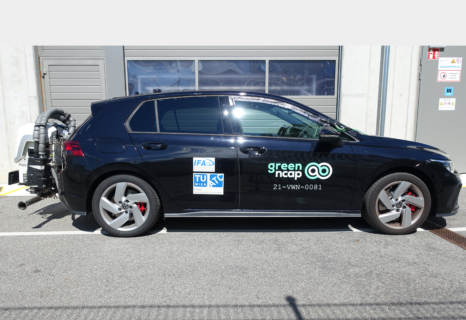VW Golf GTE 180 kW plug-in hybrid 4x2 automatic
2021
60%
6.2
10
Clean Air Index
6.2
10
Energy Efficiency Index
5.6
10
Greenhouse Gas Index
| Laboratory Tests | NMHC | NOX | NH3 | CO | PN | |
|---|---|---|---|---|---|---|
| 5.610 | Cold Test | |||||
| 6.510 | Warm Test | |||||
| 4.010 | Cold Ambient test | |||||
| 4.010 | Highway | |||||
| Road test | ||||||
| 4.810 | On-Road Drive | |||||
| 5.28 | On-Road Heavy Load | |||||
| 3.55 | On-Road Light Load | |||||
| 4.15 | On-Road Short Trip | |||||
| 2.02 | Congestion | |||||
| Robustness |
| Laboratory Tests | Energy | ||||||
|---|---|---|---|---|---|---|---|
| 5.610 | Cold Test | ||||||
| 6.810 | Warm Test | ||||||
| 2.610 | Cold Ambient test | ||||||
| 3.110 | Highway | ||||||
| Consumption | Driving Range | ||||||
| Petrol | Electric | Petrol | Electric | ||||
| Average | 5.2l | 4.9kWh | 100 km | 588 | 42 | km | |
| Worst-Case | 8.6l | 0.0kWh | 100 km | 465 | n.a. | km | |
Consumption in WLTC+ Battery Depleting Cycle: 11.7 kWh/100 km electric + 3.0 l/100 km fuel |
|||||||
| Greenhouse Gases | CO2 | N2O | CH4 | |
|---|---|---|---|---|
| 3.47 | Cold Test | |||
| 3.87 | Warm Test | |||
| 2.37 | Cold Ambient test | |||
| 2.37 | Highway |
Specifications
- Tested Car WVWZZZCDZMW31XXXX
- Publication Date 11 2021
- Vehicle Class Small Family Car
- Emissions Class Euro 6d
- Tyres 225/45 R17 91W
- Mass 1,583 kg
- Engine Size 1,395 cc
- Engine Power/Torque 180 kW/400 Nm
- Published CO2 36 g/km
- Declared battery capacity 13.0 kWh
- Published driving range 52 km








































































































































Our verdict
The new Volkswagen Golf GTE is a plug-in hybrid of a very dynamic character with a system power of 180 kW and 400 Nm of torque. It comes as a combination of a 110 kW 1.4 litre turbocharged direct injection petrol engine, a 6-speed double-clutch transmission, an 85 kW electric motor and a battery of 13 kWh declared capacity. All these components add to a relatively high weight but help the vehicle score well in all three parts of Green NCAP's assessment. Despite being equipped with a gasoline particle filter, particle number emissions are still not as low as they could be, and ammonia is another compound that would benefit from attention. The hybrid management makes effective use of the power sources and combines them well enough to achieve low consumption values and moderate CO2 emissions without compromising agility. Regular charging will provide the greatest benefit from the plug-in hybrid architecture. Overall, the GTE is awarded a very creditable result of 3½ green stars and proves the potential of well-developed alternative powertrains.